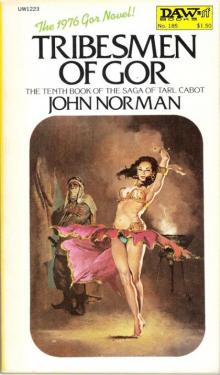- Home
- John Norman
Explorers of Gor coc-13 Page 14
Explorers of Gor coc-13 Read online
Page 14
We could see men on the docks and on the outjutting wharves. Many seemed to recognize the Palms of Schendi and she was well received. I had not realized that Schendi was as large or busy a port as it was. Many of the wharves were crowded and there were numerous ships moored at them. On the wharves and in the warehouses, whose great doors were generally open, I could see much merchandise. Most in evidence were spice kegs and hide bales, but much else, too, could be seen, cargos in the warehouses and on the wharves, some waiting, some being actively carried about, being embarked or disembarked. As the Palms of Schendi, her canvas now taken in and the long yards swung parallel with the deck, oars lifting and sweeping, moved past the wharves many men stopped working, setting down their burdens, to wave us good greetings. Men relish the sight of a fine ship. Too, the two girls at the prow did not detract from the effect. They hung as splendid ornaments, two slave beauties, dangling over the brownish waters, from rings set in the ears of a beast. We passed the high desks of two wharf praetors. I saw, too, here and there, brief-tunicked, collared slave girls; I saw, too, at one point a group of paga girls, chained together, soliciting business for their master’s tavern. Many goods pass in and out of Schendi, as would be the case in any major port, such as precious metals, jewels, tapestries, rugs, silks, horn and horn products, medicines, sugars and salts, scrolls, papers, inks, lumber, stone, cloth, ointments, perfumes, dried fruit, some dried fish, many root vegetables, chains, craft tools, agricultural implements, such as hoe heads and metal flail blades, wines and pagas, colorful birds and slaves. Schendi’s most significant exports are doubtless spice and hides, with kailiauk horn and horn products also being of great importance. One of her most delicious exports is palm wine. One of her most famous, and precious, exports are the small carved sapphires of Schendi. These are generally a deep blue, but some are purple and others, interestingly, White or yellow. They are usually carved in the shape of tiny Panthers, but sometimes other animals are found as well, usually small animals or birds. Sometimes, however, the stone is carved to resemble a tiny kailiauk or kailiauk head. Slaves, interestingly, do not count as one of the major products in Schendi, in spite of the fact that the port is the headquarters of the League of Black Slavers. The black slavers usually sell their catches nearer the markets, both to the north and south. One of their major markets, to which they generally arrange for the shipment of girls overland, is the Sardar Fairs, in particular that of En’Kara, which is the most extensive and finest. This is not to say, of course, that Schendi does not have excellent slave markets. It is a major Gorean port. The population of Schendi is probably about a million people. The great majority of these are black. Individuals of all races, however, Schendi being a cosmopolitan port, frequent the city. Many merchant houses, from distant cities, have outlets or agents in Schendi. Similarly sailors, from hundreds of ships and numerous distant ports, are almost always within the city. The equatorial waters about Schendi, of course, are open to shipping all year around. This is one reason for the importance of the port. Schendi does not, of course, experience a winter. Being somewhat south of the equator it does have a dry season, which occurs in the period of the southern hemisphere’s winter. If it were somewhat north of the equator, this dry season would occur in the period of the northern hemisphere’s winter. The farmers about Schendi, as farmers in the equatorial regions generally, do their main planting at the beginning of the “dry season.” From the point of view of one accustomed to Gor’s northern latitudes I am not altogether happy with the geographer’s concept of a “dry season.” It is not really dry but actually a season of less rain. During the rains of the rainy season seeds could be torn out of the ground and fields half washed away. The equatorial farmer, incidentally, often moves his fields after two or three seasons as the soil, depleted of many minerals and nutriments by the centuries of terrible rains, is quickly exhausted by his croppage. The soil of tropical areas, contrary to popular understanding, is not one of great agricultural fertility. Jungles, which usually spring up along rivers or in the vicinity of river systems, can thrive in a soil which would not nourish fields of food grains. The farmers about Schendi are, in a sense, more gardeners than farmers. When a field is exhausted the farmer clears a new area and begins again. Villages move. This infertility of the soil is a major reason why population concentrations have not developed in the Gorean equatorial interior. The land will not support large permanent settlements. On the equator, itself, interestingly, geographers maintain that there are two dry seasons and two rainy seasons. Once again, if there is much to this, I would prefer to think of two rainy seasons and two less rainy seasons. My own observations would lead me to say that for all practical purposes there is, on the equator itself, no dry season. The reason for the great amount of rain in the equatorial regions is, I suppose, clear to all. At the equator the sun’s rays are most direct. This creates greater surface heat than oblique rays would. This heating of the surface causes warm air to rise. The rising of the warm air leaves a vacuum, so to speak, or, better, an area of less pressure or density in the atmosphere. Into this less dense area, this “hole,” so to speak, cooler air pours, like invisible liquid, from both the north and south. This air is heated and rises in its turn. When the warm air reaches the upper atmosphere, well above the reflecting, heated surface of the earth, it cools; as it cools, its moisture is precipitated as rain, This is, of course, a cycle. It is responsible for the incredible rains of the Gorean equatorial interior. There are often two major rains during the day, in the late afternoon, when the warm air has reached its precipitation point, and, again, in the late evening, when, due to the turning of the planet, the surface and upper atmosphere, darkened, cools. There can be rain, of course, at other times, as well, depending on the intricate interplay of air currents, pressures and temperatures.
“Oars inboard,” called Gudi, who acted as oar master.
Seamen hurled mooring lines to men on the wharf. These were looped about heavy mooring cleats. Coils of rope slung over the side cushioned the strakes of the ship, lest she grate herself on the boards of the wharf. Men gathered their gear. The gangplank was run from an opening in the starboard rail, swung open, to the wharf. The number of the wharf was eight.
I saw two slavers stop at the wharf, looking up at the slaves suspended from the rings. “If you want to sell them, bring them to the market of Kovu,” called one of them, an ugly fellow, his right cheek disfigured by a long scar.
Shoka lifted his hand to them, acknowledging that he had heard them.
They then continued on their way.
Beautiful slave girls, clothed and unclothed, are not that rare on Gor. That the two girls had attracted the attention of passing slavers was high praise indeed for their unconcealed charms.
Two men from the desk of the nearest wharf praetor, he handling wharves six through ten, a scribe and a physician, boarded the ship. The scribe carried a folder with him. He would check the papers of Ulafi, the registration of the ship, the arrangements for wharfage and the nature of the cargo. The physician would check the health of the crew and slaves. Plague, some years ago, had broken out in Bazi, to the north, which port had then been closed by the merchants for two years. In some eighteen months it had burned itself out, moving south and eastward. Bazi had not yet recovered from the economic blow. Schendi’s merchant council, I supposed, could not be blamed for wishing to exercise due caution that a similar calamity did not befall their own port.
The scribe, with Ulafi, went about his business. I, with the crew members, submitted to the examination of the physician. He did little more than look into our eyes and examine our forearms. But our eyes were not yellowed nor was there sign of the broken pustules in our flesh.
Two slave girls, white, barefoot, in ragged brown tunics, with golden rings in their ears, one chewing on a larma, came to stand on the wharf near the prow. “How ugly you are!” called up one of them to the girls at the rings.
“Have you ever been put at the prow?” called Sasi ba
ck to them, unhesitatingly.
They did not respond.
I saw the blond-haired barbarian, suspended at her ring, suddenly shudder with understanding. And then how proud she seemed, bound there, suddenly. She looked up at her bound wrists and the large ring. Her feet moved, rubbing slightly against one another; her ankles, crossed and bound, shifted in the small encircling rope loops which held them closely together. The line of her body, suspended as she was, was very beautiful. She looked over at Sasi, and Sasi smiled at her. Then, to my amazement, the blond girl, though her wrists must have hurt her, her weight drawing against them, smiled back at Sasi. Then she looked down with contempt at the ragged girls on the wharf.
“You are both homely, poor slaves!” called up one of the girls.
“You are homely, poor slaves, not we?” said Sasi. “We are at the prow!” She looked at them, angrily. “Were you ever at the prow?”
Again they did not answer.
Can your master not afford to give you a decent tunic?” asked Sasi. I smiled, for Sasi, herself, did not have a stitch to wear. I would have her improve her slave skills considerably before I would let her have so much as a rag. “I wager your master has you dance for male slaves!” cried Sasi.
The two girls cried out with rage and the one girl hurled the core of the larma at Sasi, stinging her on the lower right abdomen.
“Pierced-ear girls!” cried Saul.
The two girls suddenly looked at one another and, sobbing, turned and fled from the wharf.
Sasi looked back at me, well pleased with herself~ I had to admit she had handled the two girls well. I also recalled that she had, once, in the voyage, begged me to have her own ears pierced, that she might be then all the more helplessly and irrevocably a slave. I did not know If she had changed her mind on this issue, but it did not matter. I looked at her. Yes, rings would look well in her ears. I would, thus, have her ears pierced, or would do it myself. I also looked at the blond-haired girl. Her ears, too, I decided, would look well with rings in them. She would soon have pierced ears, set well with golden rings, should she come into my ownership.
The blond-haired girl looked at me, and then looked away. I was pleased. I could see how proud she was to have been found beautiful enough to be put at the prow of a Gorean ship. Perhaps for the first time she was beginning to sense how lovely she truly was.
How ignorant women are. Do they not know how beautiful they are? Do they not know how incredibly exciting they are to men? Do they not know how they are wanted, how fiercely they are desired. If only they could see themselves but once through a man’s eyes, would they not be terrified to leave the house, lest they be stripped and put under the iron, and collared, by the first man who sees them? Perhaps it is well for women not to know how desirable they are. How they might fear men, if they but knew. I speak, of course, of the men of Gor and those of a Gorean nature.
And yet on Gor women who are put in collars do not long remain ignorant of their own beauty and its meaning. It is soon taught to them, for they are slaves. Perhaps it is only the slave girl, of all women, kneeling and owned, placed uncompromisingly at the mercy of men, who had some sense of her own desirability. What woman can begin to understand men, who has not been owned by one?
“Bring in the slaves,” said the physician.
One seaman held Sasi’s rope taut, above the deck ring. Another undid the bowline which fastened the rope to the ring. Shoka, with a hook on a pole, drew Sasi back to the rail. He put aside the pole, and, one hand about her waist, drew her to him, lifting her then over the rail. He placed her on her back on the deck, her ankles still bound, her wrists, still tied, back over her head.
The physician bent to examine her.
Shoka then retrieved the pole and extended it outward, to draw the blond-haired girl back to the rail.
She was very beautiful. Her eyes, briefly, met mine as Shoka lifted her over the rail. He placed her on her back, beside Sasi, her wrists and ankles, like those of Sasi, still tied. Her arms, like Sasi’s, elbows bent, were back and over her head.
“Oh!” she cried, handled as a slave girl.
Curious, the physician touched her again. She whimpered. squirming. “She’s a hot one,” said the physician.
“Yes,” said Ulafi.
The girl looked at the physician with horror, tears in her eyes. But he completed her examination, looking into her eyes, and examining the interior of her thighs, her belly, and the interior of her forearms, for marks.
Then the physician stood up. “They are clear,” he said. “The ship is clear. All may disembark.”
“Excellent,” said Ulafi.
The scribe noted the physician’s report in his papers and the physician, with a marking stick, initialed the entry.
“May I wish you good fortune in your business in Schendi,” said Ulafi.
“Yes, thank you, Captain,” I said. “My thanks to you, too, for a line voyage.”
He nodded. “Thanks, too,” said he, “for the use of your pretty little dark-haired slave for the prow.”
“It is nothing,” I said.
“I wish you well,” said he.
“I wish you well,” said I.
I bent to Sasi’s bonds, and freed her. Then I took a pair of slave bracelets from my pouch and braceleted her hands behind her back. I would have to find lodging.
“Put that one,” said Ulafi to a seaman, indicating the bound, blond-haired girl, “in sink and chain her to a ring on the wharf. We will not have her run away again, as she did in Port Kar.”
“Yes, Captain,” said the man.
I went and gathered up my sea bag, Sasi behind me braceleted, to my left.
I heard the blond-haired girl being locked in silk. She was then freed of the ropes on her.
She was pulled to her feet by the chain at her throat, that attached to the sink, collar. The sirik collar was close-fitting and would not, like a work collar, fit over the shipping collar. The shipping collar was thrust up her throat, under her chin, where it would be easy to check. The sink collar then had been locked about her throat below it. I did not think the girl would be let out of the shipping collar until she had been delivered into the hands of the slaver, Uchafu, who was to be her buyer. Ulafi, commendably, was taking no chances with the wench. I did not think, however, that she would be likely to attempt to escape again, anyway. She had now learned something of her slavery, and she had felt the whip. Too, surely she could remember the fed of the scimitar of discipline on her ankles at Port Kar, at the desk of the wharf praetor. At a word from Ulafi her feet would have been cut off. Mercifully she had been only whipped, thereafter being identified as what she was, a slave, by brand and collar. I did not think she would wish to lose her feet. I did not think she would attempt to escape again.
Shoka pulled her down the gangplank and, near the ship, with a length of chain and a heavy padlock, running the chain through the sink chain, fastened her to a ring.
She knelt there, on the hot boards.
She looked up at me, naked and chained.
For an instant I saw again, in her eyes, the secret slave of her. Then I saw her eyes try to deny the slave. She bit her lip, and looked down. “No, no,” she whispered to herself, in English.. “I am not a slave.”
“Are you going to sell me in Schendi?” asked Sasi.
“Perhaps.” I said. “I will, if I wish.”
“Yes, Master,” said Sasi.
The blond-haired girl’s head was down.
I supposed the secret slave knew well that her jailer was the blond-haired girl. But I did not think the blond-haired girl realized, or fully realized, that she herself was the slave she so cruelly suppressed.
The blond-haired girl then, timidly, lifted her eyes to mine.
I looked at her.
Gorean men, despite her will, would free that slave. The blond-haired girl would have no choice but to become her deepest, fullest and most ancient self. The lies of her false civilization cast aside, the veneers o
f her acculturation rent and discarded, being of no interest to Gorean men, who did not share them, the deepest and most primitive female animal in her would be liberated. She would be made to be a woman.
Frightened, the blond-haired girl quickly put down her head.
She trembled. The chains moved. She seemed small.
I continued to look upon her.
Yes, she would be made to be a woman, and in the fullest sense of the word, that of a love slave to strong men.
I turned to leave.
“Master!” she cried.
I turned about, to again face her.
“Do not go,” she said. “Please do not leave me!”
“I do not understand,” I said.
“Take me with you,” she begged.
“I do not understand,” I said.
“Please buy me,” she said. She looked up at me, tears in her eyes, lifting her chained hands to me. “Please, Please, Master, buy me!” she said.
“He already has a girl,” said Sasi, angrily.
“Be silent,” I said to Sasi.
“Yes, Master,” she said.
“Do you beg to be purchased?” I asked the blond-haired girl.
“Yes, Master,” she said.
“Only a slave begs to be purchased,” I said. It is regarded as an acknowledgment of their slavery, that they can be bought and sold.
“I am a slave,” she said.
“Yes,” I said, “but you do not yet really know it.” She looked at me.
“You have not yet begun to learn your collar,” I told her.
“Buy me,” she said. “Teach it to me.”
“You tempt me, lovely slut,” I said.
She looked up at me.
“Kiss my feet,” I told her.
She did so, in her chains, kneeling on the hot boards of the wharf at Schendi. Then again she looked up at me.

 Avengers of Gor
Avengers of Gor Kajira of Gor coc-19
Kajira of Gor coc-19 Mercenaries of Gor coc-21
Mercenaries of Gor coc-21 Witness of Gor coc-26
Witness of Gor coc-26 Witness of Gor
Witness of Gor Beasts of Gor coc-12
Beasts of Gor coc-12 Rebels of Gor
Rebels of Gor Mariners of Gor cog[oc-30
Mariners of Gor cog[oc-30 The King th-3
The King th-3 Captive of Gor coc-7
Captive of Gor coc-7 The Captain th-2
The Captain th-2 Vagabonds of Gor coc-24
Vagabonds of Gor coc-24 Explorers of Gor
Explorers of Gor Hunters of Gor
Hunters of Gor The Chieftan th-1
The Chieftan th-1 Outlaw of Gor
Outlaw of Gor Priest-Kings of Gor coc-3
Priest-Kings of Gor coc-3 Norman Invasions
Norman Invasions Marauders of Gor coc-9
Marauders of Gor coc-9 Kur of Gor coc-28
Kur of Gor coc-28 Time Slave
Time Slave The Chieftain
The Chieftain Kur of Gor
Kur of Gor Rogue of Gor
Rogue of Gor The Totems of Abydos
The Totems of Abydos Tribesmen of Gor coc-10
Tribesmen of Gor coc-10 Renegades of Gor coc-23
Renegades of Gor coc-23 The King
The King Tarnsman of Gor
Tarnsman of Gor The Usurper
The Usurper Captive of Gor
Captive of Gor Conspirators of Gor
Conspirators of Gor Smugglers of Gor
Smugglers of Gor Savages of Gor
Savages of Gor Savages of Gor coc-17
Savages of Gor coc-17 Fighting Slave of Gor
Fighting Slave of Gor Nomads of Gor coc-4
Nomads of Gor coc-4 Fighting Slave of Gor coc-14
Fighting Slave of Gor coc-14 Swordsmen of Gor cog[oc-29
Swordsmen of Gor cog[oc-29 Priest-Kings of Gor
Priest-Kings of Gor Guardsman of Gor coc-16
Guardsman of Gor coc-16 Hunters of Gor coc-8
Hunters of Gor coc-8 Dancer of Gor coc-22
Dancer of Gor coc-22 Prize of Gor coc-27
Prize of Gor coc-27 Conspirators of Gor cog[oc-31
Conspirators of Gor cog[oc-31 Slave Girl of Gor
Slave Girl of Gor Explorers of Gor coc-13
Explorers of Gor coc-13 Assassin of Gor coc-5
Assassin of Gor coc-5 Raiders of Gor coc-6
Raiders of Gor coc-6 Tarnsman of Gor coc-1
Tarnsman of Gor coc-1 Dancer of Gor
Dancer of Gor Outlaw of Gor coc-2
Outlaw of Gor coc-2 Guardsman of Gor
Guardsman of Gor Beasts of Gor
Beasts of Gor Ghost Dance
Ghost Dance Nomads of Gor
Nomads of Gor Prize of Gor
Prize of Gor Rogue of Gor coc-15
Rogue of Gor coc-15 Swordsmen of Gor
Swordsmen of Gor